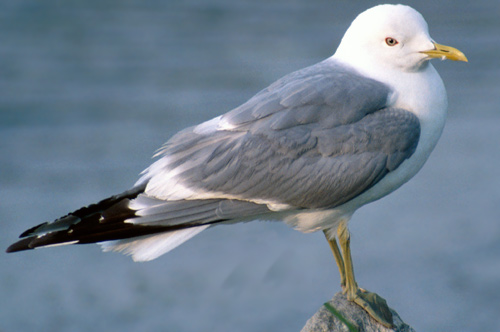| Kingdom: Animalia Phylum: Chordata Class: Aves (Birds) Order: Charadriiformes Family: Laridae |
 Mew Gull (Larus canus)
Mew Gull (Larus canus) is a occasional visitor in India. Mew Gulls are smaller, white-headed gulls so named for the "mewing" sounds of their breeding calls. Their Latin name, Larus canus, reflects their coloration and means "gray- and white-haired gull". Mew Gulls inhabit rocky, sandy coasts and inland lakes and rivers. Size: 43 cm Identification: As breeding adults, these 109 cm gulls are solid-white above and below, with light-gray wings and backs and dark gray tails. Although solid-white in summer, their heads and napes are washed in brown in winter. Their large, dark eyes are rimmed in red. Thin and solid yellow, their unmarked bills distinguish Mew Gulls from all other gulls (except Kittiwakes). Calls: The call of the Mew Gull is a high-pitched mewing, reminiscent of a mewing kitten. Their calls are higher and weaker than those of Herring Gulls and begin with high squeals. When alarmed, the call is a rapid series of nasal and yapping notes, "yadadadadada…" Nests: Typically found nesting in solitary pairs, Mew Gulls may build nests in conifers, in marshes or on the ground. However, protective cover is a critical factor in selection of all nesting sites. Assembled by both parents, cup-shaped ground nests are placed in shallow depressions (scrapes) in the highest part of the habitat (river bars, dry land or marshes). Alternatively, shallow cups are formed in platforms of seaweed, twigs, mosses or lichen placed on the tops of low-growing spruces or stumps. In marsh habitats, these gulls often build floating platforms. Scantily lined with dry grasses, the nests house the 2-3, 57 cm eggs of the clutch. Adults aggressively defend their nests, often diving and swooping upon intruders. Eggs are brownish-olive buff in color, marked in brown and occasionally wreathed. Both parents participate in incubation of the clutch, which lasts from 24-26 days. Young birds fledge in another 30-32 days post-hatching. Food: Although predominantly scavengers, Mew Gulls are known to hunt insects, earthworms, mollusks, crustaceans and occasionally young birds and mice. To break open hard shells, these clever gulls drop prey, such as sea urchins, from heights onto the beach. These omnivorous gulls also feed on grain, garbage and fish. They may congregate by the thousands at garbage dumps and fish docks to scavenge and pirate food from each other. Both parents feed chicks regurgitated meals (mostly fish) through the fledging stage. When foraging, Mew Gulls glean food from the surface of the ground or shoreline. They also take food from the water's surface or just below while floating or swimming. |
 birding.in
birding.in
| Birds | Bird Diagram | Ornithology | Indian Sites | Bird Watching | Migration | North India | Birds of India | Haryana |
All rights reserved. Copyright © 2005-2013 Birds and birding in India. Disclaimer
website: Free Java Guide & Tutorials